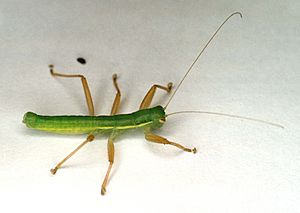Mantophasmatidae facts for kids
Quick facts for kids GladiatorsTemporal range: Jurassic–Recent
|
|
|---|---|
 |
|
| Mantophasma zephyra | |
| Scientific classification | |
| Kingdom: | |
| Phylum: | |
| Class: | |
| Subclass: | |
| Infraclass: | |
| Superorder: | |
| Order: |
Notoptera
|
| Suborder: |
Mantophasmatodea
|
| Family: |
Mantophasmatidae
|
The Gladiators are a special group of insects. Their scientific name is Mantophasmatidae. These amazing insects were only discovered recently, in 2002! They are a unique family of meat-eating insects found in Africa.
Gladiators are the only family in their entire insect order. This makes them quite rare and special. They are not very well known by any common name, but "gladiators" is the most popular one.
Contents
Where Do Gladiators Live?
Today, most gladiators live in western South Africa and Namibia. Scientists believe they used to live in many more places a long time ago. This is because they have found old fossils of gladiators in other areas. These fossils suggest they had a wider home range in the past.
What Do Gladiators Look Like?
Gladiators are unique insects because they do not have wings. They stay wingless even when they are fully grown! This can make them a bit tricky to find and identify in nature.
They look like a mix between two other interesting insects. Imagine an insect that has parts of both a praying mantis and a stick insect. Scientists have studied their DNA. They found that gladiators are most closely related to insects called icebugs.
How Were Gladiators Discovered?
The first gladiators were found in old museum collections. Scientists looked at specimens that had been collected a long time ago. These first discoveries were from Namibia and Tanzania.
One important discovery was a 45-million-year-old specimen. It was found preserved in Baltic amber. Amber is fossilized tree resin, like a natural time capsule! This ancient fossil helped scientists learn more about these insects.
Today, scientists recognize many different types of gladiators. This includes both living species and fossilized ones.
Images for kids
See also
 In Spanish: Mantophasmatidae para niños
In Spanish: Mantophasmatidae para niños


